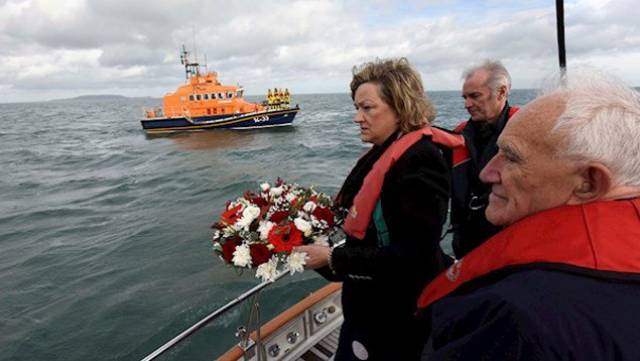When an “explosion of a storm” tore its way through the Fastnet yacht race off the Irish coast 40 years ago, there were those among the survivors who could not speak about the experience for years writes Lorna Siggins
However, over 100 sailors, rescuers and relatives of Fastnet ’79 competitors were not quite so lost for words in Howth Yacht Club, north Dublin yesterday as they gathered to remember the event.
The first full reunion of crews among Irish yachts involved in the race began with a wreath-laying at sea by the RNLI Howth lifeboat in memory of those who died.
Although the official death toll in the yacht race was initially stated at 15, and then 19, the actual figure is 21, according to Commodore John Kavanagh, now retired from the Naval Service, who was in command of the LÉ Deirdre patrol ship during the rescue effort.
Cdr Kavanagh recalled how two of the fatalities were a young couple who had joined a spectator boat, Buck’s Fizz, in Cowes shortly before the Fastnet race start from the southern English coast on August 11th, 1979.
“When we picked up that upturned catamaran, all four crew had lost their lives – but the bodies of the young couple were never actually found,” he said.
“There will never be a storm like that again – only because now we rely on sophisticated forecasting and real-time information about its progress,” Cdr Kavanagh observed.
Drawing on photographs taken by one of his ship’s crew, he recalled the LÉ Deirdre’s role in locating yachts, after the ship’s barograph measuring atmospheric pressure fell by 25 millibars in the space of ten hours.
RNLI Baltimore lifeboat coxswain Kieran Cotter, who was a crew member out on rescues for up to 75 hours in 60-knot winds, and lightkeeper Gerald Butler, who had been stationed on the Fastnet, were among the guests at the event organised by Kevin Burke, Kieran Jameson and Brian Lennon.
Kevin Burke was on board the Rapparee, a nine-metre (30 ft) Shamrock, designed by Ron Holland, which rolled over to 180 degrees at one point – and eventually made it into Dunmore East, Co Waterford.
His fellow crew, navigator John Marrow and Enda O’Coineen, recalled how they managed to communicate with an RAF helicopter by Motorola hand-held radio, and only knew the full extent of the disaster when the pilot informed them he had “bodies to pick up”.
The 18 Irish-flagged 1979 Fastnet yachts represented yesterday included crews from Cork vessels Golden Apple of the Sun owned by the late Hugh Coveney, Wild Goose, Moonduster, Irish Mist 111, Tom O’Shanter and Clayton Love Junior's Silver Apple of the Moon.
Michael O’Leary, who had been on Golden Leigh, was among crews from ten Dublin yachts at the event, while Donal McClement, RAF search and rescue pilot sailing on Black Arrow and Sally O’Leary, crew on the British-flagged yacht Yeoman XXI, also attended.
Journalist Winkie Nixon paid tribute to the rescue agencies, including RNLI lifeboats from the Scilly Isles and Penlee in Britain, from Baltimore, Ballycotton and Courtmacsherry in Co Cork and Dunmore East, Co Waterford .
They spent up to 75 hours at sea in what was described as the largest ever peace-time maritime rescue operation, along with the Naval Service, the Royal Navy, Dutch Navy, US Navy and HM Coastguard.
“When someone saves your life, you can never repay them,” Mr Nixon observed, quoting from the biography of Ron Holland who, he said, had written the best account of those four days.
The 1979 Fastnet race was to have been the climax of an Admiral’s Cup series that Ireland was tipped to win, and there were almost 3,000 recreational sailors at sea, with minimal safety equipment and few VHF radios on some spectator yachts.
They were scattered between the Scilly isles and the Fastnet – some competing and many following the 605 nautical mile course from the Isle of Wight and back to Plymouth – when a French forecast gave the first indication of the gathering maelstrom.






























































